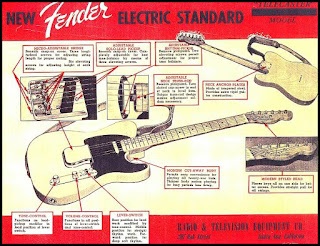Introduction
With the wiring mostly done, the last stage was to add my chosen pickups, get the control plate mounted and fasten down the scratch guard. These should have been easy tasks, but that non-standard body was continuing to threw spanners in the works.The control plate was overlapping one of the pickguard screws.
The Route to Success
After some thought, I took the decision to alter the body, as it's already been modified and repaired at the bridge routing. The control cavity would have to be widened on one side, but not having many woodwork tools, I wondered how best to do this. (chisel, Dremel with circular blade, drill loads of holes?)I was sure most of the methods I had available to me would look terrible, so I ordered a cheap mini-router from eBay and a selection of router bits.
 |
| My new Katsu mini router |
Next I clamped a wooden guide onto the guitar body using this offset and a line I'd made on some masking tape to mark the new cavity edge. All I needed to do now was set the router depth, hold my breath and start cutting.
 |
| The body ready for routing |
 |
| The completed routing (the black line marks the edge of the plate). |
 |
| The pick guard stills needs modification. |
 |
| The pick guard modification completed. |
I finished off with a fine half-round file and re-checked that everything fitted well. The screw holes were then marked and drilled with a 2mm bit.
 |
| The copper shielding in place. (notice twisted pickup wires to reduce hum) |
The body had been shielded with copper tape, so before finishing the electrical work, I replaced this with gardeners anti-slug copper tape. This stuff is quite cheap, I just cut off the serrated edges or trimmed down as required. I then applied a little plumbers flux to the stuck down edges and soldered all the pieces together. (They need to form one continuous cover)
The pickup mounting springs were replaced with neoprene tubing, and I found that a little bit of lubrication helped them fit over the pickup mounting bolts. It's a common modification that removes microphonic pickup noise, but I figured it was better to do it now. Then it was onto the socket.
 |
| Modern screw fitted output jack. |
The final step was to solder the pickups and output jack onto the pre-wired control plate and ensure all ground connections were made properly. Screwing things back together before testing is tempting fate, so I plugged it into my THR5 amp and checked the wiring before buttoning it all up. To my surprise everything worked, those Seymour Duncan wiring diagrams were spot on.
 |
| The completed guitar body. |
I like it.

















